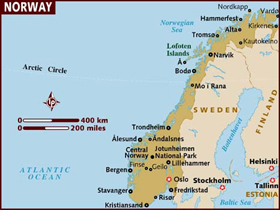Pharmacoeconomic Guidelines: Norway
Country/Region: Norway

PE Guidelines
Guidelines on how to conduct pharmacoeconomic analyses (March, 2012)
PDF in English
PDF in English
PE Guidelines Source:
he Norwegian Medicines Agency
http://www.legemiddelverket.no/
http://www.legemiddelverket.no/
Information current as of Wednesday, August 15, 2012
Key Features
| Key Features | |
|---|---|
| Type of Guidelines | PE Guidelines |
| Title and year of the document | Guidelines on how to conduct pharmacoeconomic analyses (March, 2012) |
| Affiliation of authors | NOMA, the Norwegian Medicines Agency |
| Purpose of the document | To improve the basis for decision making as regards granting of reimbursement for drug expenses in the National Insurance Scheme. Specially as to whether the cost of a medicine is in reasonable proportion to the therapeutic value and the costs associated with alternative treatment(s). |
| Standard reporting format included | Yes, a reference case is stated |
| Disclosure | Yes |
| Target audience of funding/ author's interests | NOMA staff, pharmaceutical companies and contracted health economists preparing economic analyses for use in applications to NOMA |
| Perspective | Societal point of view, but with some limitations (see the section about costs) |
| Indication | Approved indication |
| Target population | The patient population to be treated with the pharmaceutical under study. Age, gender, health status, relevant comorbidity and prognosis (both untreated and treated with the most relevant of current treatments) should be stated. |
| Subgroup analysis | Separate calculations must be performed for the different sub-populations if the intervention is expected to differ significantly in cost and / or efficacy for different patient groups. |
| Choice of comparator | The comparator(s) should be the one (those) most likely to be partially or wholly replaced, typically established practice and/or the most widespread. If it is not clear whether this (these) is (are) cost-effective compared with other relevant comparators or with no treatment, then all these options should be included. If neither of the aforementioned comparators are the one(s) recommended by the national clinical guidelines, then this (these) should be used as well. |
| Time horizon | Long enough such that all relevant important differences in future costs and health effects between treatment alternatives are captured. |
| Assumptions required | All assumptions must be clearly stated and accounted for. |
| Preferred analytical technique | Cost-Utility Analysis (CUA) |
| Costs to be included | All resource usage related to the provision of each of the included treatments in Norway. Special considerations: Inclusion of productivity gains and costs due to the treatment effect is not compulsory; costs related to added/extra life years and deadweight loss due to tax funding should not be included. |
| Source of costs | Norwegian Directorate of Health, Norwegian Medical Association, HELFO, Statistics Norway (non-exhaustive list) |
| Modeling | Yes. But the internal and external validity of the model(s) should be carefully evaluated. |
| Systematic review of evidences | Yes. Compulsory to make use of relevant databases (Medline, Embase, Cochrane, etc). State search, inclusion and exclusion criteria. Data from randomized controlled trials (RCTs) with adequate internal and external validity are preferred as the main basis for documenting health effects. |
| Preference for effectiveness over efficacy | Yes. Any available data on effectiveness should be incorporated in the analysis in order to correct/support the efficacy data. |
| Preferred outcome measure | Quality-Adjusted Life-Years (QALY) and Life-Years Gained (LYG) |
| Preferred method to derive utility | Generic MAU instruments preferred. And it is compulsory to perform a systematic literature review in order to document that the Quality of Life (QoL)-data used in the analysis is of the highest possible quality (in relation to practicality, reliability and validity). |
| Equity issues stated | Yes, the distributional profile of the reimbursement decision must be reported. |
| Discounting costs | A real discount rate of 4%. |
| Discounting outcomes | A real discount rate of 4%. |
| Sensitivity analysis-parameters and range | Parameters with the greatest potential influence on model outcomes (e.g. key clinical variables and costs), identified in a Tornado-diagram and if necessary by experts. |
| Sensitivity analysis-methods | Deterministic and/or probabilistic methods, depending on the source of uncertainty under study (methodological, parameter, structural or generalization uncertainty) |
| Presenting results | Results of the analyses must be presented both at an aggregated level and broken down into categories for both costs and health effects |
| Incremental analysis | Yes |
| Total costs vs effectiveness (cost/effectiveness ratio) | Yes |
| Portability of results (Generalizability) | Yes, Norwegian context |
| Financial impact analysis | Yes, with a five-years perspective |
| Mandatory or recommended or voluntary | Mandatory |
Acknowledgement: